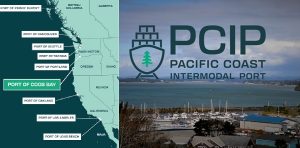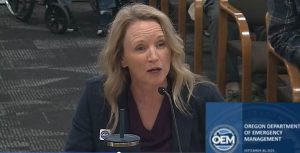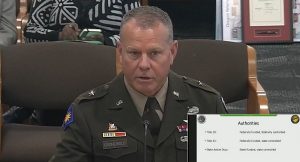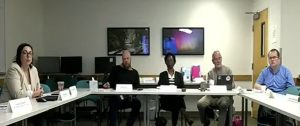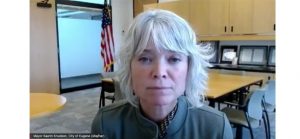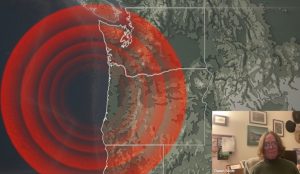It’s up to us to protect our communities this fire season
8 min read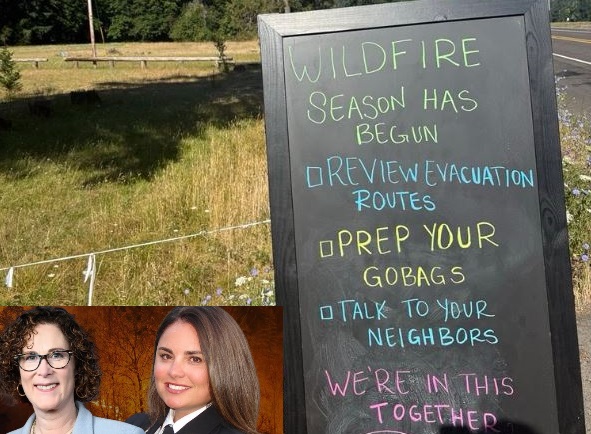
Presenter: All the signs indicate: The Pacific Northwest and Northern California face a formidable fire season ahead. July 9, U.S. Representative Val Hoyle:
Rep. Val Hoyle: As we all know, wildfires are getting more intense and more frequent and especially for those of us who live near the forested areas, near urban areas, we need to realize that we have to protect ourselves. We need to take safety into consideration.
[00:00:32] Presenter: Oregon State Fire Marshal Mariana Ruiz-Temple:
[00:00:36] Mariana Ruiz-Temple (Oregon, state fire marshal): I’ve been with the Department of the State Fire Marshal for 30 years, so 30 different fire seasons. And I think that like any Oregonian, we know that things are evolving.
[00:00:46] I wanted to start with kind of just talking about what the conditions on the ground are today, and every area of Oregon is in some level of drought. You overlay that with the temperatures that we’re seeing and we’re starting to see above-normal seasonal temperatures throughout the entire state of Oregon.
[00:01:05] And in my 30 years, I have never seen our entire state in red, but then you overlay that with Northern California and the entire state of Washington. And that puts the West at the highest levels of alertness, I would say, but then also in a competition of resources.
[00:01:24] And so when we talk about wildfire response, the best firefighter in a lot of cases is us, as Oregonians, and being better prepared on how we can help protect our own property in advance of wildfire.
[00:01:38] We are the second in the nation to have a statewide community wildfire risk reduction program. And at the core of it is defensible space. And if you’re interested in getting a free assessment or you’re interested in tools and tips to kind of assess your own property, there’s easy things that we can do on our own property that can help us defend our own property, and these are best practices.
[00:02:05] I’ve lived here my whole life. I, like many of you, have been evacuated or in evacuation zones, and I, like some of you, have had significant wildfire loss in a wildfire. And so when I’m speaking about this, I want you to know I’m coming at it from someone that’s also been through a wildfire and has lost a home in a wildfire.
[00:02:25] So I can really understand sometimes when people are, these are easy things, but that can be expensive or I can never get to them. But I do know that they actually do help in some cases.
[00:02:38] And I would say the very first thing that’s the most important is the zero-to-five-foot zone. So what kind of materials and vegetation do you have right close to your zero to five foot? Do you have vegetative fuels that are going to draw fire? That is the first place that we say to take a look at.
[00:02:58] The easiest thing is trim up any kind of vegetation around that home, any kind of trees that are near your roof, clean your gutters, that’s also very easy thing that we can do and where embers can land and then cause a fire.
[00:03:14] And you know, from my experience, the best thing that I would tell my friends, family, and any Oregonian is: Sign up for Oregon Alerts. It’s OR-Alert. It’s right there. It’s super simple. You put in your address. And this is for any event. This could be for a winter storm. It could be for a tsunami. It could be for a wildfire. And it’ll give you the most updated information and alerts any time of day. And that will give you the best information on should you prepare for evacuation.
[00:03:46] Presenter: When they issue evacuation alerts, Level 1 means Ready, Level 2 means Set, and Level 3 means Go Now! Mariana Ruiz-Temple.
[00:03:58] Mariana Ruiz-Temple (Oregon, state fire marshal): The one thing I would always say, especially where folks are tuning in to this is that we should always be just in Level 1. We should always have that mindset of like, where would I go? What is my route? What would I take with me?
[00:04:10] Secondly is if you do do OR-Alert, it’s going to give you that kind of extra time to be better defendable for your family and your friends and your pets and know that you’re going to be in a Level 2 or a Level 3.
[00:04:23] The other thing that I would talk about from experience is a lot of times we get accustomed to Level 2 and we’re like yeah do we really need to leave but we know how quickly in your areas how you can go to a Level 3.
[00:04:34] And so the best thing I could say is always be in a Level 1 sign up for alerts and heed the warnings because you could always come back you could always come back to your home if they quickly go back to different levels but you may not be able to always be able to get out completely safely if you quickly go from a (Level) 2 to a (Level) 3.
[00:04:51] And so as Oregonians, the best thing we can do is know the alerts, know the restrictions, and take the time, a little elbow grease and education to know what you can do around your property in that defensible space, what you can do to your structure to home-harden your structure, and know where you would go if you really get into a Level 3 type incident.
[00:05:16] Presenter: She was asked, is there anything that people should keep on hand in the car in case of a wildfire emergency. State Fire Marshal Mariana Ruiz-Temple:
[00:05:27] Mariana Ruiz-Temple (Oregon, state fire marshal): Yeah, that is a great question. And I can tell you that I consider myself, like, the things that I do. I have a go bag, right? Like what would I need in 72 hours? What kind of medical prescriptions do I need? Do I have food for my dog? Do I know where I’m going? So the immediate need of what do you need to take care of yourself for 72 hours?
[00:05:53] The other thing that I like to say too is, like, what’s important to you. After I lost my home I realized really quickly, I was not prepared on what was important to me. And so now I know like if these things are important to me I’m going to have those ready to go around the Level 1 or Level 2.
[00:06:09] So but in terms of what I would put in there, you’ll see that I where’s my medicine? Where’s my food? What am I going to do to take care of myself for 72 hours? Is my phone charged? Do I have my phone charger? Those kinds of things.
[00:06:22] I think that once you are alerted to where to go, very quickly you’re in a certain place where you have kind of those essentials like water and food and those kinds of things because counties in Oregon are doing a really good job of creating those pods and places where people go.
[00:06:38] But the things that are important to you and the things that you need in 72 hours, especially medical, are important.
[00:06:44] Presenter: What is the plan for wildfire response and recovery if FEMA doesn’t come to help? The Oregon State Fire Marshal:
[00:06:52] Mariana Ruiz-Temple (Oregon, state fire marshal): Yeah, great question. One that we get often right now. You know, there’s a lot of federal uncertainty that we are all experiencing. One thing I like to level-set is that FEMA doesn’t necessarily have a response posture, but they do have a very important role in assisting states with funding to either recovery or response. So: more financial and a resource.
[00:07:18] I think what’s important for myself and ODF is that we have a strong state response posture. The state of Oregon just finished their legislative session. There are dollars in there for the first time—the first time in my career—to provide dedicated funding around mitigation dollars. So that is a big deal. That’s how do we get money pre-fire to get out of the ‘ER’ philosophy that Oregon is in, where we wait until fire and then we’re in trouble. So that’s a plus.
[00:07:50] Presenter: For east wind conditions, will there be pre-positioning of resources, including an incident command team? Mariana Ruiz-Temple:
[00:07:59] Mariana Ruiz-Temple (Oregon, state fire marshal): Yeah, that’s a great question. Yes. In 2020, we leaned in starting on Saturday, alerting local areas to do mandatory callbacks. In that case, we had an east wind event that was going to go border to border.
[00:08:15] So local regional wind events, and it doesn’t even need to be an east wind event, but certainly all of us that experienced that, remember that.
[00:08:26] Just today, we had a conversation, we have these ‘pre-po’ conversations: Do weather conditions require it? Does capacity require it? If the answer is yes, you’ll see us pre-position.
[00:08:38] And sometimes it’s not just about east wind events. Sometimes it’s about areas of the state that take a long time to mobilize to, like a Klamath area, for example, that might experience something that we know have a reduced capacity because they rely on a volunteer system.
[00:08:51] So the answer is yes, for sure, in east wind events. Those are things that we will continue to do like we did in 2020. But in addition to, we do that throughout the season based on those two indicators, weather and capacity.
[00:09:05] Everyone plays a role. Everyone is a firefighter. And what are we doing as property owners and residents to help protect? That is our responsibility. Because if you live in certain areas of state when you call 911, you might not have the capacity available or the time needed.
[00:09:21] Wildfire happens every season in Oregon. It’s getting worse. It’s getting more complex. It’s starting earlier and it’s going longer. We know that as Oregonians now.
[00:09:31] And if you look at natural disasters, wildfire is the one natural disaster on this earth that we can mitigate. And that’s because we can do things to our own property, we can be defendable in ways that you can’t with tornadoes, ways that you can’t with hurricanes.
[00:09:45] Presenter: State fire marshal Mariana Ruiz-Temple and Rep. Val Hoyle ask us July 9 to help reduce risk in the fire season ahead.
